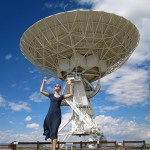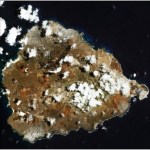space
Besides our blogs being about two very different topics I seem to have a much more crass interpretation of things.
For example Phil says this "I don't want to live in a place where transdimensional spaceworms can appear in the sky and blast superheated steam straight down onto innocent earthlings."
I see things very differently. This picture clearly shows an anus coming down from space and mega fart blasting Montana. I guess it doesn't really matter since neither one is very pleasant.
The author, dishing.
To get to the National Radio Telescope Observatory, you have to be committed.
Well, first, you have to be in New Mexico -- about an hour's drive south of Albuquerque, in the plains of San Augustin, to be precise, a Pleistocene lakebed bordered by the northern end of the Chihuahuan Desert and dotted with arid shrubs. Despite being some 6,970 feet above sea level, it feels like the basement of the world, wide and flat and under the massive Southwestern sky. Driving to the Observatory, the home of the famous "Very Large Array" of radio telescopes, is an exercise in…
Jalopnik has some wonderful pictures of relics from the Soviet Lunar Lander program, abandoned after the success of Apollo 11.
Life transforms environments, creating ecosystems where there was once only rocks. The evolution of photosynthetic bacteria billions of years ago created the atmosphere we have today, paving the way for the evolution of larger, oxygen-breathing organisms. We humans obviously transform our environment in countless ways, but can we also engineer barren environments to be hospitable to life? Can we create new living, self-sustaining ecosystems in hostile places? Can we turn lifeless planets into second Earths through the clever introduction of life forms?
Terraforming is the (currently…
Greetings from the People of Earth from World Science Festival on Vimeo.
I made the above video, Greetings from the People of Earth, to open the World Science Festival 2010 panel "The Search for Life in the Universe," which featured personal hero Jill Tarter, David Charbonneau, and Steven Squyres.
In 1977, taking advantage of a fortuitous alignment of planets, NASA dispatched two spacecraft named Voyager into space. These probes, now the farthest human-made objects from Earth, carry with them a unique recording, the Voyager Golden Record. Compiled by a team under Dr. Carl Sagan, the Golden…
Shortly after my buddy Jeff Medkeff died in 2008, a joint book review of ours was published in Skeptic Magazine. Here we criticised a book by Alan Bond and Mark Hempsell, two aeronautics engineers, where they claimed that a 7th century BC cuneiform tablet from Mesopotamia described an asteroid striking the Austrian Alps in 3123 BC. Their argument was in our opinion extremely speculative or pseudoscientific, regardless of whether you saw it from an astronomical, geological or archaeological point of view.
Bond & Hempsell self-published their book. But to my surprise, the summer issue of…
By Dr. Adrian Brown
Planetary Research Scientist at the Carl Sagan Center for the Study of Life in the Universe, SETI Institute
The last two months have witnessed several extremely important events with respect to future Mars Exploration. The first two revolved around the rover "Spirit." The other two are a new mission to Mars and a possible road for humans to Mars.
"Spirit"
On June 3rd, the Mars Exploration Rover (MER) team published a stunning paper describing how the rover "Spirit," now immobile in the shifting sands of Gusev Crater, detected carbonate minerals in a rock called "Comanche…
By Dr. Mark R. Showalter
Planetary Astronomer at the Carl Sagan Center for the Study of Life in the Universe, SETI Institute
In 1609, Galileo introduced to the world his new invention, the astronomical telescope. It opened up new opportunities to explore a territory that all prior generations had regarded as familiar--the night sky. In short order, he was making major discoveries. But the sky is very big and Galileo's telescope was very small. He had to choose his targets carefully.
In that context, Saturn was nothing special, the least of the known planets, just a bright point in a black…
Earlier this week, there was some interesting discussion of science communication in the UK branch of the science blogosphere. I found it via Alun Salt's "Moving beyond the 'One-dinosaur-fits-all' model of science communication" which is too good a phrase not to quote, and he spun off two posts from Alice Bell, at the Guardian blog and her own blog, and the proximate cause of all this is a dopey remark by a UK government official that has come in for some justifiable mockery.
Bell and Salt both focus on the narrowness of the "dinosaurs and space" approach-- a reasonably representative quote…
Readers, help me sort out an egregious detail of astronomical lore.
The most common method of classifying stars -- Harvard Spectral Classification -- was thought up by one of the most famous female astronomers of all time, Annie Jump Cannon. Adapted from a cumbersome older method which sorted stars into 22 alphabetical categories of observable hydrogen in their spectra, the Cannon method orders stars from hottest to coldest. This, despite being functional and elegant, left her (and us) with an unpronounceable acronym: OBAFGKM. With the recent addition of two colder categories of stars, the…
Imagine with me, for a moment, that the zombie invasion has begun. You try to escape, but the zombies are just too much to handle. You can't run fast enough. They're everywhere. Your favorite science bloggers have been turned into zombies and they're coming for you.
Figure 1: Thanks to Joseph Hewitt of Ataraxia Theatre for providing us with these awesome illustrations of zombified sciblings! Left to right: Christie, Sci, Bora, me, & Peter and Travis. Click on each to embiggen.
I'm sure you've always wondered what would happen as a zombie ate through your brain. How would it feel? What…
by Nathalie A. Cabrol
I realize how immodest the title of this first blog may sound and it is certainly not my intention to convince anybody that I will answer this question in the limited space allowed here or even in a lifetime. My hope is, instead, to stir thoughts and invite an exchange of diverse perspectives to make this a thread that we can all pull from time to time. It is an immense subject debated in an abundant literature, but discussing it is certainly not the exclusive privilege of those called explorers. All beings, from the greatest minds to the simplest forms of life on this…
I believe the world is a complex phenomenological experience that can be explained, rationalized, and lived in myriad different ways. The way I see it, we all begin with the same fundamental mystery -- why are we here? what is life? -- and we attack this problem with whatever tools we find work best; some of us use science, parsing and decoding the secrets of life with a toolbox of methods and reason. Others, with the same goals in mind, use art, arranging ideas and objects in intentional ways designed to root at the questions of existence. Others still depend on the framework of religion to…
Last week, fresh off the fourth-to-last Shuttle mission, STS-131, NASA astronaut Jim Dutton came to speak at OMSI, my local science museum. When I got the email about this event, I RSVPed immediately -- after all, an astronaut in my town? How urbane. Surely the intelligentsia of Oregon would come in droves to discuss the boggling phenomenological experience of spaceflight and the uncertain future of NASA with one of our nation's "right stuff." As usual, I was wrong; the only adult in the museum unaccompanied by a least one small child, I felt somehow like a pervert, as though the harried…
If it has always been your fantasy to send your physical likeness out into the cosmos, now is your time! To commemorate the final two Shuttle missions, NASA has created a bonkers "Face in Space" initiative, which allows you to upload a picture of yourself to send to the International Space Station. What this actually entails, I imagine, is a burned data DVD in an astronaut's backpack -- nominal space travel if I've ever heard of it.
It's fun, and my face is already destined to launch on September 16th on STS-133; but, seriously, what is this about? Rousing public interest in the space…
As NASA's Space Shuttle program winds down -- Endeavour's final mission is slated for later this year, then that's it -- let us take a moment and remember the Shuttles. Sure, they had a tendency to explode into balls of fire. Sure, they were expensive, risky, and besieged by problems. But now is not the time for criticism: 25 years of American engineering, 132 missions, and over 20,000 orbits of this planet are nothing to shake a stick at. It is in this spirit of recognition that Universe presents a very subjective chronology of the Shuttle's greatest moments. Onward!
Gene Roddenberry, Star…
It should not come as a surprise to the regular reader of this blog that a lot can be learned about animal cognition by simply observing animal behavior. But can observing animal behavior lead the observer to make inferences about brain anatomy? Can observing animal behavior tell us something about the evolution of the brain?
Figure 1: Like the raccoon says.
Let's say you have two very very closely related species. You might even call them congeneric, because they are from the same taxonomic genus. In most ways, these two species are very similar, but they differ behaviorally in some very…
Zen recently wrote mentioned this study on his blog, so I thought it was time to dredge it out of the archives. Also, I've just returned from APS (see my daily recaps here here and here), and I am TIRED.
Domestic animals and their wild counterparts can be different in big ways; there can be differences in morphology (physical characteristics), physiology, and behavior. These changes may depend on spontaneous adaptations to captivity or to artificial selection pressures arising from the motivation for domesticating the animal in the first place.
One change that is often observed as a result of…
DAYDREAMING is a critical component of conscious experience. The mind can perform mental time travel - it occasionally strays from the present moment, to recollect an experience from the near or distant past, or to imagine an event that has not yet taken place. We know that thinking about the future is dependant on memory, because patients with amnesia cannot imagine new experiences. It involves piecing together fragments of past experiences to generate a plausible simulation of what might happen. This may have been an important development in human evolution, as it enables us anticipate a…











